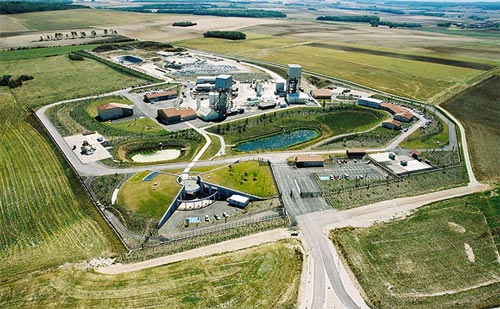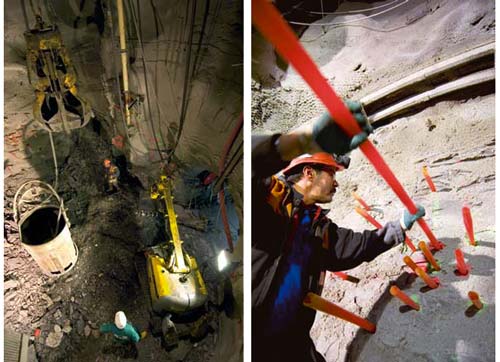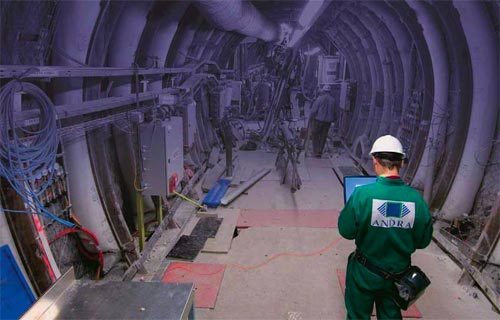Bure underground laboratory
A research laboratory for a disposal facility site

Bure: the laboratory on the surface
View of the surface facilities in the Champagne countryside. The work to bore the shafts began in 2000. Two experimental drifts were excavated at depths of 445 m and 490 m and went into operation in 2004 and 2005.
© ANDRA
Before high-level radioactive waste is buried deep underground almost for eternity, every precaution must be taken. The quality of the host rock has to be checked. It needs to be verified that the geological strata hundreds of metres below the surface do indeed have the qualities attributed to them.
This is the reason why France has built an underground laboratory at Bure, on the boundary between the Meuse and Haute-Marne départements, in a geologically very stable part of the Paris basin. After the granite option was abandoned, the construction of this laboratory became essential to carry out research into the Callovo-Oxfordian clay that lies at a depth of around 500 m in this area.

Excavations
Excavations for the Bure underground laboratory. One of the first studies was to identify the impact of the construction and operation of a disposal facility on the geological formation. The boring and excavation work showed that the clay layer was uniform over a large area, that there were no faults and that it was suitable for excavation.
© ANDRA
The construction of the laboratory was preceded by an exploration phase from 1994 to 1996. It was a case of finding out about the main features of the geological environment, checking how the layers were arranged, and obtaining the first details about the clay layer’s characteristics.
The work to sink the shafts, which began in October 2000, reached the desired depth of 500 m in 2005. The excavation of the experimental drifts at 445 m and 490 m enabled the clay medium to be observed in situ and allowed the first work to be carried out, showing in particular that the Callovo-Oxfordian argillite had the expected properties.
The experimental drift at a depth of 445 m has been operational since November 2004 and, in addition to housing the experimental equipment for monitoring deformation of the rocks during the sinking of the main shaft, it also hosts a major programme of geomechanical, hydrogeological and geochemical experiments.
Objectives of the research and experiments
The research aims to explore all the possible causes of radioelements rising to the surface. It studies the chemical reactions, water movements, glaciation effects, earth tremors and human intrusions that could cause the radioactive material to rise.
rising to the surface. It studies the chemical reactions, water movements, glaciation effects, earth tremors and human intrusions that could cause the radioactive material to rise.
The first objective is to confirm, from the data collected, the geological hypotheses on which the design of the disposal facility is based. Modelling plays a crucial role because of the envisaged timescales, and has to be validated. The models have to be linked to the results of measurements.
The second objective is to specify the water movements, including in the limestone layers adjacent to the Callovo-Oxfordian, that could cause elements to migrate once they have passed through the clay barrier. An estimate has to be made of the proportion of radioelements that will rise to the surface over time, carried by water circulating in the rock.
The third objective is to characterise the damage caused by the construction of the shafts and drifts. How does the rock respond to the disturbances caused by the excavation of the underground laboratory? How does the damaged area change and heal over?

Experimental drift at a depth of 445 m
Experimental drift of the Bure laboratory excavated at a depth of 445 m. The experiments carried out in this drift are designed to collect data in situ on the damage to the argillite during the excavation works and on fluid/rock transfers and interactions in the Callovo-Oxfordian argillites.
© ANDRA
This research requires some very varied disciplines. Some CNRS laboratories and universities are also taking part in it. The CNRS is a partner of ANDRA in this research, under various programmes: New Options for Waste Management (GEstion des DEchets par des Options Nouvelles or GEDEON); Deep Geological Formation (FORmation géologique PROfonde or FORPRO); New Materials for Waste (NOuveaux MAtériaux pour Déchets or NOMADE); Physics and Chemistry of actinides and other radioelements (Physico-chimie des actinides et autres radioéléments or PRACTIS). A multidisciplinary approach is taken, involving the earth sciences, chemistry and mathematical simulation.
ANDRA videos
– Video of the history of research into disposal and the CIGEO project: ***view video***
– Virtual tour of the Bure laboratory (the virtual tour shows real images enabling you to explore the laboratory and the research being carried out there): ***view video***
Other articles on the subject « Geological disposal »
Waste duration
Nuclear spent fuel and vitrified waste: what legacy? “Much of this nuclear waste will remai[...]
CIGEO project
CIGEO – Overview of a planned repository The efforts made by engineers to ensure that highl[...]
Clay medium
The Callovo-Oxfordian argilite The geological stratum or ‘host rock’ that will[...]
Results on deep clay disposal
What we know about the disposal facility site In its final report in 2006 the French National Ass[...]
High-level waste repositories
Disposal of high-level waste packages The high-level waste packages requiring disposal will proba[...]
ILW-LL waste repositories
Filling an intermediate-level waste disposal cell Intermediate-level (ILW-LL) waste releases litt[...]
Waste disposal USA
Back to the drawing board after Yucca Mountain WIPP, the first deep geological repository to begi[...]
WIPP Project
The world’s first deep geological repository The United States is the first country in the [...]
Waste disposal Sweden
Sweden and Finland – Exemplary waste management Sweden probably features among the E[...]
Other countries
Shared challenges and similar solutions In most countries with nuclear industries, solutions for [...]